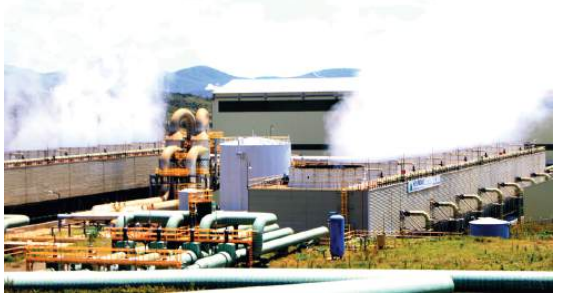![Local power production by source [KWh million]](/_next/image?url=https%3A%2F%2Fcdn.radioafrica.digital%2Fimage%2F2025%2F09%2F55999cb3-d16d-4e13-a40f-eabbd07bd72b.jpeg&w=3840&q=100)
Local power production by source [KWh million]
Wind energy contributes 776.32 million kWh.
At least 10.1 million Kenyans were already connected to the grid by the end of the financial year 2024/2025.
In Summary

Audio By Vocalize
 KenGen Ol Karia IV power production plant /FILE
KenGen Ol Karia IV power production plant /FILEWednesday is the most productive day for Kenya’s economy, with
power production peaking at an annual average of 41.01 GWh.
The annual Energy and Petroleum Sector Statistics Report for the period ended June 30, 2025, released in Nairobi on Tuesday, shows that the country’s daily demand profile is a direct reflection of socio-economic activities throughout the daily cycle.
Tuesdays and Thursdays followed closely, recording averages of 40.57GWh and 40.45GWh respectively. The lowest demand day was on Sunday, averaging 34.96GWh.
Large commercial and industrial consumers are the major drivers of electrical energy consumption in the country, with monthly consumption exceeding 15,000 kWh.
Customers in this category comprise industries and factories, high-rise buildings, warehouses, and public infrastructure such as airports, ports, and railway stations.
According to the data by the Energy and Petroleum Regulatory Authority (EPRA), this category of consumers accounted for 49.61 per cent of total electricity consumption in the country, using 5,620.71GWh.
Even so, its dominance as the largest energy consumer category reduced from 51.86 per cent in the previous financial year to 49.6 per cent due to an increase in the consumption share of other categories.
The low consumption is synonymous with Kenya’s current tough economic situation, which has forced the majority of firms to close shop, scale down, or seek more affordable production means.
Generally, total electricity consumption increased during the period under review, hitting a new peak demand of 2,316.2 MW.
This is a 6.38 per cent rise over the previous year’s peak demand of 2,177 MW, reflecting robust economic growth where domestic consumption registered a significant 13.03 per cent increase to 3,640.32GWh, while small commercial consumers were up 11.5 per cent or 197.72 GWh to stand at 1913.26GWh.
Additionally, street lighting consumption saw a notable increase of 43.9 per cent, and electric mobility consumption rose by 300per cent to 5.04 GWh.
Daniel Kiptoo , director general at Epra, expressed optimism on the increased electricity consumption, saying it reveals a positive trajectory in the sub-sectors.
"We saw large-scale energy consumers save about Sh1.44 billion from using the Time-of-Use (TOU) tariff, which reached a cumulative 180.3 GWh in consumption. We also saw growth in E-mobility, where its energy consumption rose by 300 per cent to 5.04 GWh,’’ Kiptoo said.
“We aim to improve this further by removing the 15,000-unit monthly consumption cap for e-mobility users.”
The report also reveals growth in regional interconnection thanks to the completion of the 210-kilometre 400kV transmission line to Tanzania, enabling strategic interconnections with Ethiopia, Uganda, and Tanzania.
During the year under review, electricity imports from Ethiopia (EEP) amounted to 1,274.42GWh, accounting for 83.09 per cent of total imports, Uganda (225.64GWh) or 14.71 per cent, while Tanzania accounted for 33.79GWh or 2.2 per cent.
The energy sector’s ambition of attaining 100 per cent clean energy continued in earnest, with renewable energy accounting for 80.5 per cent of total generation.
Geothermal energy accounted for 39.51percent of total energy generated, hydro generation (24.21 per cent), Wind (13.18 per cent), and solar energy standing at 3.27 per cent.
At least 10.1 million Kenyans were already connected to the grid by the end of the financial year.
The initiative by the state to promote LPG uptake in households, institutional use and for autogas saw LPG consumption rise by 15 per cent from 360,594 metric tonnes in 2023 to 414,861 metric tonnes during the period under review.
The sub-sector is poised for exponential growth as the government deploys LPG reticulation in 5,000 public schools and the rollout of the same programme within mass housing projects.
The regulator has permitted 16 retail autogas dispensing stations and the construction of 18 new stations in the current year.
Similarly, the petroleum sector saw a rise in domestic demand for products, rising by 6.94 per cent (5,839,464.78 m³), primarily attributed to a decline in local and international prices, which, in turn, stimulated heightened economic activity.
The report also highlights a significant restructuring of Kenya's petroleum blocks, reconfiguring them into 50 high-potential blocks to attract new investment and exploration.
![Local power production by source [KWh million]](/_next/image?url=https%3A%2F%2Fcdn.radioafrica.digital%2Fimage%2F2025%2F09%2F55999cb3-d16d-4e13-a40f-eabbd07bd72b.jpeg&w=3840&q=100)
Wind energy contributes 776.32 million kWh.